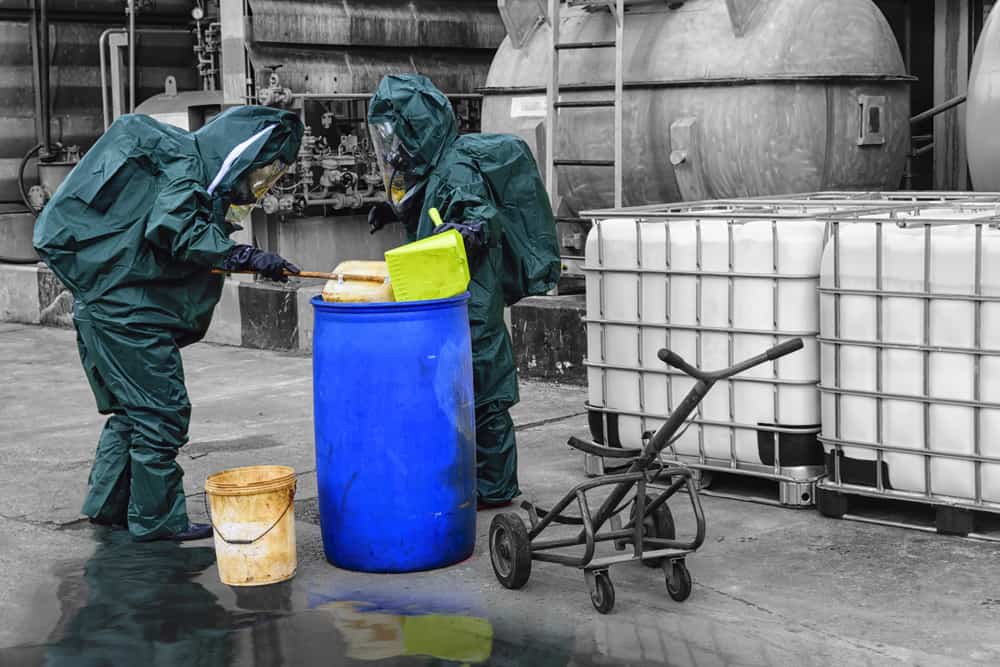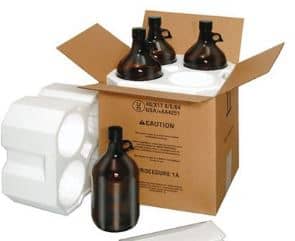Chemical Spill Incident During Receiving Process: What Happened?

A chemical spill incident was triggered when a cardboard carton was lifted by an employee, the bottom opened and one of the 2.5 liter bottles in the box fell and broke.
On May 3, 2017, a chemical spill occurred at Brookhaven National Laboratory (BNL). Here’s what happened: Three cardboard cartons arrived at the receiving warehouse (Building 98). Each carton contained six 2.5 liter bottles of 6 Lithium Chloride (6LiCl) solution. When one of these cartons was lifted by an employee, the bottom opened and one of the 2.5 liter bottles in the box fell and broke.
Fire Rescue was called and they cleaned the spill using sodium bicarbonate and spill pads and placed the waste into plastic buckets. The pH of the liquid was checked using pH indicator paper and had a pH of 0 (highly acidic). The label on the box indicated it was shipped from the National Institute of Science and Technology (NIST) to a Principal Investigator (PI) in Building 555 (Chemistry). There were no other DOT markings or labels on the box. The label on the bottle indicated the content was 10 Molar 6LiCl.

The analysis of this chemical spill event uncovered weakness in the BNL system of receiving materials when they are not procured through the normal ordering or purchasing process
The packages were not part of a purchase order involving a commercial chemical vendor, rather, they were chemicals being provided by an offsite collaborator to a researcher at BNL. Analysis. This event revealed deficiencies in the following areas:
- Transportation: This material was most likely a Class 8 Corrosive liquid. BNL was sent multiple packages that were not in compliance with the DOT regulations that include hazard class determination, shipping documentation, packaging, marking, and labeling. The physical packaging was less than adequate, as only one strip of tape was used to close the bottom of the carton.
- Chemical Management System: When chemicals are procured through the normal purchase process, they are identified during the receiving process as chemicals and sent to the CMS area for bar codes and entry into the CMS database. DOE LESSONS LEARNED The Chemical Safety program (Subject Area) has a provision for receiving chemicals from other research institutions; however it requires the final receiver of the material to notify the CMS so it can be barcoded and tracked in the system. In previous chemical shipments of this chemical from NIST, these requirements were not followed.
- Chemical Safety: The offsite researcher supplied an SDS for a 6% 6LiCl l solutions which incorrectly stated pH of 6. Also the bottles were not labeled in accordance with the Global Harmonization Standard (GHS) requirements. The BNL first responders quickly determined that the pH was 1 or less with pH test paper and responded correctly. However, the receiving clerk had no indication that there were any chemicals in the cartons, and had no way of identifying the corrosive hazard during the breakage.
- Spill Response by receiving personnel: A review of how the receiving personnel respond to breakage of incoming or staged material determined that clearer instructions were needed. In the case of unknown chemical spills, employees should immediately leave the area and call the emergency response personnel (2222 or 911).
- Accountable Materials: The 10 molar 6LiCl contains enriched 6Li which is a DOE accountable nuclear material. During the investigation it was found that this was not the first shipment of this material received by the BNL researcher from the offsite researcher. The BNL researcher received one carton with three 2-liter bottles weeks before this incident. Each individual bottle did not reach the reportable inventory threshold level for accountability control however, the addition of the 3 cartons of unbroken bottles, 17 in total, to the storage area at the Chemistry Building required the material to be managed under BNL material control and accountability (MCA) program. The Nuclear Material Management Group responded and placed the material in the BNL MCA inventory control system.
- Experimental Safety Review (ESR) Process: BNL uses the ESR process to review hazards and risks for each experiment performed by BNL researchers. In this, event was the erroneous SDS supplied during the ESR process which did not indicate a corrosive hazard. If it was, did the BNL researcher expect to receive a 6% 6LiCl solution? If he did, how was the ESR updated when the increase to 10 M was agreed to between the two researchers? If the BNL researcher knew during planning that they were receiving a 10M 6LiCl solution, as a user of the material should they have realized that the liquid would have to have a low pH to stay in solution? The ESR process is described in the Standard Base Management System in the Work Planning and Control Subject Area. The ESR will identify storage and handling risks for hazardous chemicals (i.e. corrosive) and inventory control requirements for Accountable Nuclear Materials.
As part of the corrective actions for the chemical spill event, the ESR was updated.
Here are the DOE Lessons Learned and Recommended Actions:
- Work with scientific staff to shift their mindset from words like “sample,” “reagents,” and “components” to chemicals when planning experiments can help focus users on risk.
- Empower the receiving staff to question items that could be chemicals, but not identified on the boxes or shipping documents. Receiving staff should move the packages to the CMS team for evaluation to help prevent events like this.
- Ensure that the Experimental Safety Review process is robust enough to identify hazards and accountability issues throughout the entire experiment. Encourage all BNL staff to ask for help from subject matter experts early in the process to address issues before they become an event.
- Encourage the BNL research staff, when arranging delivery of non-procured materials from other research facilities, to ask their counterparts to make shipments through their institutions shipping department. In this event it may not have identified the error in pH, but the material would have been appropriately packaged and marked for liquids in an inner package.
- Develop a short guide so Brookhaven researchers and collaborators at other institutions can better determine if materials may be hazardous when placed in the transportation process.
- When DOE accountable nuclear materials are being considered for use or shipment to BNL, contact the Nuclear Materials Management office for nuclear material control and accountability authorization requirements.
Lessons learned
The receipt of chemicals, not procured from a commercial vendor, can challenge multiple safety aspects if not identified as a chemical by the user. The highly complex system for shipping chemicals must be performed by well-trained, qualified personnel at both the shipping and receiving facilities.
Source: OPEXSHARE: Operating Experience/Lessons Learned/Best Practices, The Department of Energy. Originator: Brookhaven National Laboratory, Upton, NY.; Lesson ID: 2017-BNL-I1170.
Founded in 1988, the TapRooT® Root Cause Analysis System solves hurdles every investigator faces
TapRooT® Root Cause Analysis Training System takes an investigator beyond his or her knowledge to think outside the box. Backed with extensive research in human performance, incident investigation, and root cause analysis, TapRooT® is a global leader in improved investigation effectiveness and productivity, stopping finger-pointing and blame, improving equipment reliability, and fixing operating problems.
TapRooT® Root Cause Analysis Training courses are taught all over the world
System Improvements, the creator of the TapRooT® System, has a team of investigators and instructors with years of extensive training ready to offer assistance worldwide.
If you are interested in learning how to stop repeat incidents, find a 2-Day or 5-Day course; or view the complete selection of TapRooT® courses. We are available to train you and your staff on-site at your workplace; Contact us to discuss your needs. You may also call us at 865.539.2139 to discuss any questions you may have.



